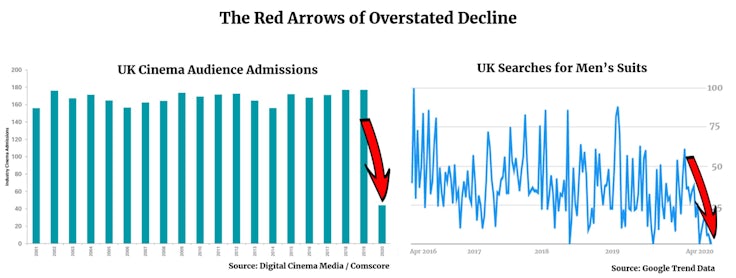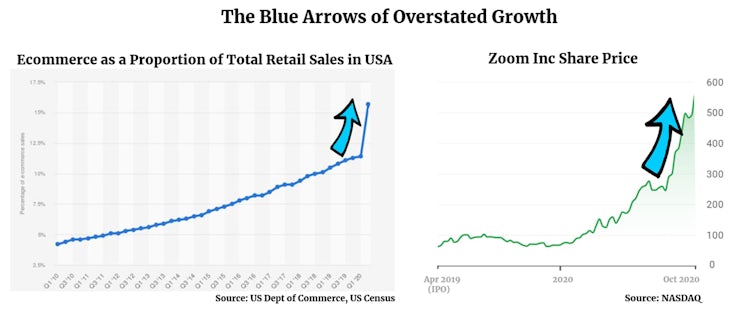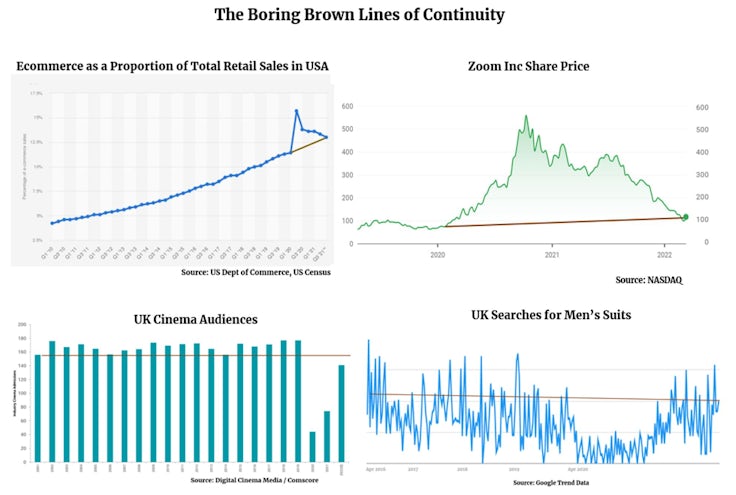Welcome to the new normal, it’s the same as the old one
Despite dire predictions of Covid-driven decline for some sectors and exponential growth for others, we’re largely where we would have been if it had never happened.

The two-year span that will be forever known as the ‘Covid Years’ was a dark time. You had to find your entertainment where you could. And, for me, one of the most consoling voices on the internet was brand consultant Martin Lindstrom. He talked such utter bollocks about coronavirus and its likely impact on consumption and society that I found myself curiously comforted every time I read his nonsense.
Clearly, coronavirus was a dreadful scourge. But, equally clearly, it was not going to be anything like as bad or as enduring as Lindstrom and other like-minded catastrophe-monkeys were predicting. So, each time I read his nonsensical coverage, I ended up feeling better about the whole thing.
In ever more frantic content, Lindstrom positioned Covid-19 as a societal force that WOULD. CHANGE. EVERYTHING. And LEAVE. NOTHING. UNTOUCHED. “This change is so profound,” he explained in 2020 to his alarmed LinkedIn audience, “that one can talk about a global synchronisation of human behaviour establishing a completely new, universal change of consumer patterns.”
And, with even more bananas hyperbole, Lindstrom predicted that this “profound”, “new” and “universal” change would render existing institutions redundant and usher in revolutionary new systems. “When it comes to malls, stores, shopping and entertainment,” Lindstrom told readers of the WWD website in 2020, “the coronavirus can be counted on to escalate the replacement of conventional brick-and-mortar models with digital. Old industries will collapse, as the space they dominated is completely redefined.”
And, of course, if you step back to those early electric months of 2020, it is easy to see why Lindstrom lost his proverbial shit. Old industries like cinema did experience unprecedented freefall. Traditional staple products – like men’s suits – suddenly lost their appeal as a new era of dressing down in sweat pants (if you were lucky) took hold. If you set 2019 as your ‘normal’, decided 2020 was the post-Covid ‘new normal’ and extrapolated accordingly, the dumb red arrows of decline pointed to exactly the “collapses” that Lindstrom was writing about.
 Meanwhile, over those same heady months at the start of 2020, there was a huge surge in alternative technologies that offered a better fit with a new and confronting Covid reality. Zoom usage went ballistic, for example, and so did its share price. And, again as Lindstrom predicted, ecommerce purchases suddenly took a much bigger share of all retail purchases. Provided you limited your analysis of history to only the most recent data points, the blue arrows of exponential growth appeared as inarguable as they were inevitable. Change was titanic and likely to change everything.
Meanwhile, over those same heady months at the start of 2020, there was a huge surge in alternative technologies that offered a better fit with a new and confronting Covid reality. Zoom usage went ballistic, for example, and so did its share price. And, again as Lindstrom predicted, ecommerce purchases suddenly took a much bigger share of all retail purchases. Provided you limited your analysis of history to only the most recent data points, the blue arrows of exponential growth appeared as inarguable as they were inevitable. Change was titanic and likely to change everything.
 But these predictions missed an enormous amount of complexity and nuance. Quite clearly, Covid was always going to change the direction of culture and consumption, and marketing with it. But, equally obviously, most marketers – like Lindstrom – would overstate and oversimplify these changes. Our discipline is obsessed with the pornography of change. And Lindstrom is the Larry Flint of this whole misalignment.
But these predictions missed an enormous amount of complexity and nuance. Quite clearly, Covid was always going to change the direction of culture and consumption, and marketing with it. But, equally obviously, most marketers – like Lindstrom – would overstate and oversimplify these changes. Our discipline is obsessed with the pornography of change. And Lindstrom is the Larry Flint of this whole misalignment.
And make no mistake, it is misalignment. With a bit more time, thought and appreciation for the longer, slower swing of the propellers of global change, we can now see that the breathless predictions of Covid-induced change are (mostly) a big bag of piss.
Everything will change forever after coronavirus…won’t it?
That is not to say there aren’t changes now being felt because of the last two years and the evil virus. I am not simply an idiot, inverted version of Lindstrom, claiming that Covid has had zero impact and that 2019 will have its destiny completely restored. The world is changing. But not at the hyper-kinetic pace that most marketing gurus propose.
Consumer attention spans are not reducing. Marketing is not changing more this year than in the five preceding years. And Covid has not created giant ruptures with the past that will turn everything we knew to ash.
But change is inherent. I subscribe to the Bill Gates school of prediction. “We always overestimate the change that will occur in the next two years,” Gates wrote in 1996, “and underestimate the change that will occur in the next 10.” Rather than bang us over the head with the dramatic barbells of Covid-induced revolution, culture and consumption change so slowly we barely notice it. Until it becomes different.
You observe change not in the sudden inflection of charts when Covid hits, but in the broader, longer progression of trends. Zoom out of the dramatic changes of Q1 2020 and look before and after them, and you clearly see broader themes now being restored. Not to where they were pre-Covid, but very close to where they would have been had Covid never existed. Not quite the same. But nowhere near as different as the barons of change would have you think. If you draw a boring brown line to mark the rough trend of the pre-Covid years and look at the rapidly rebalanced trends of 2022, it’s clear that business as usual is gradually becoming business as usual again.
My four self-serving charts all show the same picture. First there is the pre-Covid trend. Then the sudden shake of Covid change that some mistook as total revolution. Now we see significant returns back to pre-Covid levels. And those returns seem to gradually align with what we might have expected if we had stopped smoking the giant doobie of change back in 2020 and taken in the bigger, broader picture of history.
 The boring brown line of continuity is not necessarily flat. Men’s suit wearing is in very slow decline, ecommerce use continues to grow as a total proportion of purchase. But the sudden shifts that Covid introduced are dissipating.
The boring brown line of continuity is not necessarily flat. Men’s suit wearing is in very slow decline, ecommerce use continues to grow as a total proportion of purchase. But the sudden shifts that Covid introduced are dissipating.
Consumers have not stopped buying more online, but they have slowed their behaviour change compared to 2021’s trends. Partly because they could go outside again. But also because stores aren’t dying, they are simply part of a broader omnichannel experience that brands will always offer to their customers – albeit in different proportions from the ones we saw yesterday, or today, or tomorrow.
Similarly, people have not stopped using teleconferencing or stopped doing more with it. But the rapid increase in its use has slowed as meetings between actual people have resumed. Partly because those people like face-to-face meetings, partly because they have missed it, and partly because it turns out that sitting with someone represents an outstanding way to share information and interact.
The boring brown line of continuity is pointing back to normality and a future that is different, but not too different, from the past.
People also eventually got sick of tracksuit bottoms and began to lust for a two-button Prada suit and crisp white shirt again. And their search behaviour reflected that return to formality.
They also grew tired of Netflix and the minimising effect it has on new movies. So they put on their 20th-century coat and a 21st-century mask and went to the pictures, with other people, again. The UK cinema industry expects 2022 to reach 80% of the record attendances achieved back in 2019. Most of the cinema advertisers are already back advertising again.
In each of these examples, and a thousand others, the massive changes of early 2020 gradually reverted back to the much more complex mean of societal change. Of course there are outliers that have been forever changed by Covid. But these changes will ultimately prove to be exceptions, not the generalised rule. Which prompts the question: why do marketers overstate and exaggerate change so much?
Why is change so overstated?
First – and most venally – there is a lot of money to be made from change. And very little to be had from permanence. Lindstrom’s new bestselling book Buyology for a Coronavirus World is billed as a book that “makes sense of the new world order”. I might want to write a book called Consumers and Marketing Aren’t Changing That Much At All (When You Actually Look At It Properly), but who would buy it? Selling the status quo is bad business.
Never forget that almost all the sockless wonders who told you about the imminent ascension of digital targeting, influencers, Bitcoin and NFTs were making money from those aforementioned things the whole time. I’m not saying they were bent. I am saying that rationalisation is a powerful tool for self-deception and – when coupled with decent presentation skills – an even more powerful tool for mass delusion. And also most of them were bent.
Second, there is a certain slope that you can roll down when you start speaking or writing about this future-of-the-world stuff that can accelerate very quickly. First you predict X. That sounds impressive and the audience love it, so then you predict X plus Y. And before you know it the whole alphabet is being turned on its head in a orgy of future wank. And there is no-one to stop your predictive descent down the vertiginous slopes of bullshit once you start future-trundling. In space, the old movie poster told us, no-one can hear you scream. In the future, no-one can call out your bullshit predictions. Because they are still about to happen.
Third, there are many imbalances between the market we target and the marketers we are. We are more white, more male, more privately educated, more metro, more tech-savvy, more ABC1. But nestled among those many inexplicables, we are also much younger than the ‘average consumer’. That absence of age has many implications.
One of them is that most marketers are not used to change yet. We aren’t lucky enough to have marketers left who remember the impact of Spanish influenza on markets a century ago, or what happened on the high street once World War II ended. I bet they would sigh a bit and tell us that things got back to normal remarkably quickly. But those marketers have left us for the giant segmentation chart in the sky. And we have 20-somethings who experience everything for the first, extra-exaggerated time.
Finally, and most disappointingly, marketers love change because they smell safety. Half of all marketers don’t have any knowledge of marketing. No training. No big picture. No real clue. Despite their apparent pride that ‘I’ve had no formal training and look at me’, there is – I believe – a deep seated insecurity that they might be found out at any time. Hence the emphasis on change and the future looking nothing like the present. In the new world, the world changed totally by coronavirus and digital and NFTs, those who know nothing will know everything! And those who knew marketing will be left behind!
We aren’t over Covid yet. We might never be, totally. But the boring brown line of continuity is pointing back to normality and a future that is different, but not too different, from the past.







